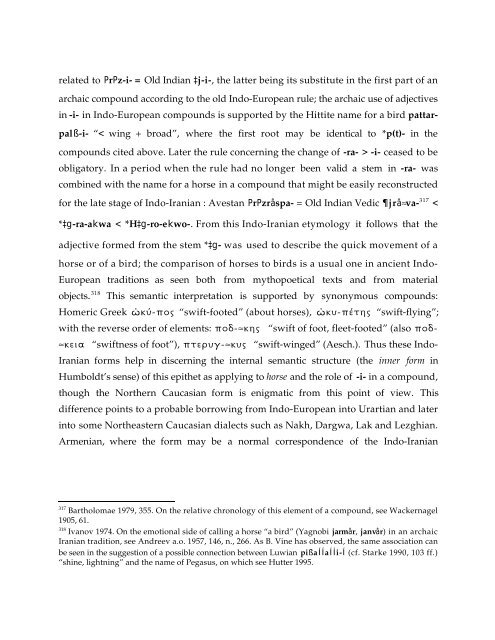Comparative Notes on Hurro-Urartian, Northern Caucasian
Comparative Notes on Hurro-Urartian, Northern Caucasian
Comparative Notes on Hurro-Urartian, Northern Caucasian
You also want an ePaper? Increase the reach of your titles
YUMPU automatically turns print PDFs into web optimized ePapers that Google loves.
elated to PrPz-i- = Old Indian ‡j-i-, the latter being its substitute in the first part of an<br />
archaic compound according to the old Indo-European rule; the archaic use of adjectives<br />
in -i- in Indo-European compounds is supported by the Hittite name for a bird pattar-<br />
palß-i- “< wing + broad”, where the first root may be identical to *p(t)- in the<br />
compounds cited above. Later the rule c<strong>on</strong>cerning the change of -ra- > -i- ceased to be<br />
obligatory. In a period when the rule had no l<strong>on</strong>ger been valid a stem in -ra- was<br />
combined with the name for a horse in a compound that might be easily rec<strong>on</strong>structed<br />
for the late stage of Indo-Iranian : Avestan PrPzrâspa- = Old Indian Vedic jrâ≈va- 317 <<br />
*‡´g-ra-a´kwa < *H‡´g-ro-e´kwo-. From this Indo-Iranian etymology it follows that the<br />
adjective formed from the stem *‡´g- was used to describe the quick movement of a<br />
horse or of a bird; the comparis<strong>on</strong> of horses to birds is a usual <strong>on</strong>e in ancient Indo-<br />
European traditi<strong>on</strong>s as seen both from mythopoetical texts and from material<br />
objects. 318 This semantic interpretati<strong>on</strong> is supported by syn<strong>on</strong>ymous compounds:<br />
Homeric Greek »kÊ-pow “swift-footed” (about horses), »ku-p°thw “swift-flying”;<br />
with the reverse order of elements: pod-≈khw “swift of foot, fleet-footed” (also pod-<br />
≈keia “swiftness of foot”), pterug-≈kuw “swift-winged” (Aesch.). Thus these Indo-<br />
Iranian forms help in discerning the internal semantic structure (the inner form in<br />
Humboldt’s sense) of this epithet as applying to horse and the role of -i- in a compound,<br />
though the <strong>Northern</strong> <strong>Caucasian</strong> form is enigmatic from this point of view. This<br />
difference points to a probable borrowing from Indo-European into <strong>Urartian</strong> and later<br />
into some Northeastern <strong>Caucasian</strong> dialects such as Nakh, Dargwa, Lak and Lezghian.<br />
Armenian, where the form may be a normal corresp<strong>on</strong>dence of the Indo-Iranian<br />
317 Bartholomae 1979, 355. On the relative chr<strong>on</strong>ology of this element of a compound, see Wackernagel<br />
1905, 61.<br />
318 Ivanov 1974. On the emoti<strong>on</strong>al side of calling a horse “a bird” (Yagnobi jarmâr, janvâr) in an archaic<br />
Iranian traditi<strong>on</strong>, see Andreev a.o. 1957, 146, n., 266. As B. Vine has observed, the same associati<strong>on</strong> can<br />
be seen in the suggesti<strong>on</strong> of a possible c<strong>on</strong>necti<strong>on</strong> between Luwian pißaÍÍaÍÍi-Í (cf. Starke 1990, 103 ff.)<br />
“shine, lightning” and the name of Pegasus, <strong>on</strong> which see Hutter 1995.





